We are approaching 2 weeks since the great earthquake. The situation appears to have calmed down somewhat with less aftershocks and some significant advancements at the nuclear power plant. But we’re not out of the water yet – contaminated food is being reported daily and drinking water is suffering the same fate. Meanwhile efforts to raise money for those stranded in the north continue and the media is under constant scrutiny.
**For the latest on the Great Tohoku Earthquake, click here.**
**End Live Updates**
13.17 To clarify the situation on radioactive iodine being detected in the tap water, here’s a link to a pdf containing acceptable limits for adults by the Nuclear Safety Commision. Check page 23. Current levels of iodine in the tap water are very low in most places: 2.9Bq/kg in Tokyo as of 20th March. For Fukushima prefecture, as of March 21st, the level was 21Bq/kg.
Legal limit for radioactive iodine 131:
Water and milk: 300Bq/kg
Vegetables (excluding root vegetables): 2000Bq/kg
Legal limit for radioactive cesium 137:
Water and milk: 200Bq/kg
Vegetables, cereals, meat, fish: 500Bq/kg
From the guide published by the Nuclear Safety Commission, revised in August 2010.
http://www.nsc.go.jp/shinsashishin/pdf/history/59-15.pdf
http://113.35.73.180/monitoring/w-past_data.html
13.15 Roy at Mutantfrog has updated his radiation safety article with the latest about food. He summarises some important points everyone would do well to read. The main points are below with a link afterwards.
Dangerous amounts of radiation under these regulations are based on dosage over an entire year, so having a little bit of food or water over the line is probably still safe.
If radiation higher than the legal limit is detected on vegetables than shipment of all vegetables of the same type from the same region is banned.
If tiny amounts below the limit still bother you than peeling the outer layer and extra rinsing should eliminate it.
All of the affected veggies so far are leafy vegetables like spinach, kakina (another green leafy veggie), and shungiku (edible chrysanthemum) so radioactive particles can stick to them more easily. It is very unlikely that root vegetables could be contaminated in this situation.
Milk at 5 towns in Fukushima exceeded the legal limit, and milk all throughout the surrounding area was tested but found safe.
Even these “unsafe” amounts are still pretty small, and if you have accidentally had just one or two servings of radioactive milk or leaves it shouldn’t be enough to harm you.
At present, all prefectures in Japan are testing drinking water daily (as I linked to above), but even water unsafe for drinking will likely still be within safe levels for washing clothes or even bathing.
Note that the safe limit for an infant (or pregnant woman, I assume-but it doesn’t say) is much lower than for adults. Limit for an adult is 300 Becquerels per kilogram of body weight, but for infants under one year is only 100.
Testing is being carried out daily, and if you live in or near the irradiated zones then be sure to check the latest news every day until the whole crisis seems to be past.
http://www.mutantfrog.com/2011/03/18/radiation-safety-update/#latest-updates
**End Live Updates**
01.29 A new charity event called 5 to Survive has begun. Head over to their website for more details on how you can easily help the disaster victims in Japan.
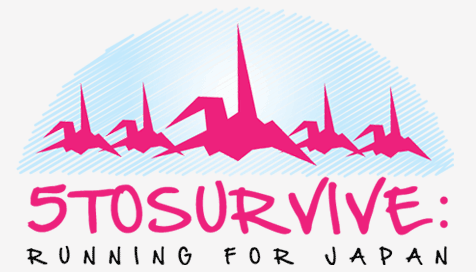
Outline:
Name: 5toSurvive: Running for Japan
Date and time: April 10th, 3.11pm.Brief explanation:
An International 5km walk/run in aid of he Japan Earthquake and Tsunami Relief. Current organised events will be happening in Ishikawa, Toyama, UK, America and Canada. We are looking to organise more events in more locations across the world through further promotion.
The proceeds will be donated to the Red Cross and Living dreams.*****
As someone who lives in Japan, I have been both shocked at the destruction caused by the earthquake and tsunami, and amazed at how people are coming together to help those in need. Watching these events unfold, I’ve had one continuous thought on my mind, ‘How can I help?’. And when I sat down to think about what I could do, I turned to what I know best: running.
As a keen runner from a young age, I have entered many races and seen what charity runs can do. Each year the London marathon raises millions for charities, and now its our turn to make a difference for Japan.
So…here’s your chance. On Sunday, April 10th, at 3:11pm I am challenging myself to run 5toSurvive — 5kms to benefit earthquake/tsunami relief — and I’m asking all of you to join me. This is an event created for everyone, no matter who or where you are, to join forces and help.
If you’re a serious runner then go for it, if you’re not then have fun! Invite some friends, put on a costume, and walk the distance with a bucket for donations along the way. The great thing is you can decide the details of your event, but you’ll be doing it with others from around the world.
The idea is to run or walk 5km and raise money by doing it. Trust me, this really is where you can make a difference. There are 47 prefectures in Japan. If one person can raise 10,000 yen per prefecture, it will be 470,000 yen. Imagine what a group of 5 or 10 of you can do! (And now imagine runs in New York, London, Toronto, LA and you see what we are going to achieve!)
It’s easy to raise money — just join the 5toSurvive team on justgiving.com and your friends and family can easily donate to GlobalGiving’s earthquake relief efforts. Here’s how you get started in a few easy steps:
STEP 1: Go to www.justgiving.com and click ‘Get Started.’ and ‘Make Your Page.’ Choose ‘Personal Challenge’ and follow the directions. Now go to https://www.justgiving.com/teams/5tosurvive/ and click ‘Join Team.’ (Down at the bottom where it lists the team members). Select the page that you just made and join the team!
STEP 2: Create your 5km course. (There’s a number of websites you can use for this, I would recommend mapmyrun.com).
STEP 3: Plan your event — Big or small, its up to you. Feel free to run on your own. Or find people to run with you: a few friends or your local AJET group, running club, or college’s Japanese Culture Association. (To add an extra element of fun, plan to wear costumes!)
STEP 4: Raise awareness and tell people to sponsor you through your justgiving.com page so you can track your progress.
STEP 5: Go out and do it!If you have any questions or are having trouble getting your 5km together, please contact [email protected].
I’m urging you to do what you can to raise donations and awareness! There really is no quick fix, and rebuilding the region will take years. By joining 5toSurvive and running or walking what is probably less than your everyday commute to work, you can be a part of a worldwide effort to remember the victims of the tsunami and give the people still struggling in the face of such devastation a helping hand. If running isn’t your thing or you want to do more then follow in mine and others footsteps, I’d encourage you to organise something by yourself or with your friends!
Thanks! And I’ll see you on the starting line.
– Tom
Brought to you by Mr. Tom Cole, AJET, Smile Kids Japan, JetWit and JETAA.
01.07 A nice little video here of citizens giving their support for the people in the stricken areas of northern Japan. The man at the end (1:10) is especially moving. He says:
被災地の皆さん、頑張ってくださいとは言いません。どうか私たちに遠慮なく甘えてください。頑張らなくていいので、皆さんの元気な姿が見たい、一日も早くみたいと思っております。
Those people in the stricken areas, I won’t ask you to do your best. Please, don’t hesitate to depend on us for help. You don’t need to struggle. I want to see you lively and well again as soon as possible.
http://www.youtube.com/watch?v=hisfBrqJUNQ
Thanks to VirtualVoid for grabbing the video for me!
http://www.nhk.or.jp/news7/movie.swf?v=end110321
01.00 Radioactive iodine has been detected in the water supply in Iitate village, Fukushima prefecture. Levels are not high enough to harm health, but citizens are being advised by the Ministry of Health, Labour and Welfare to avoid drinking it unless there is no other water source available. As of March 20th, 965 becquerels per kilogram were detected, but this had declined to 492 becquerels on 21st. The village is giving out 3 litres of water per person to drink. Iitate is a village within the 20-30km radius from the nuclear power plant and residents are advised to stay indoors.
http://www.47news.jp/CN/201103/CN2011032101000811.html
00.56 Japan Times has provided a clear chart of the current radiation readings in east Japan. All readings are in MICRO sieverts. As you can see, outside of Fukushima itself, there is very little effect.

http://search.japantimes.co.jp/mail/nn20110321a2.html
00.24 There have been reports of elevated levels of radiation recently due to the rain over Tokyo and other areas. Edano reassured the public on television that the levels were not harmful, but that it would be better to stay out of the rain or weather some protective clothing if outdoors.
TEPCO have also got a note explaining why rain causes elevated levels of radiation on their website. Basically, as you might expect, radiation floating about in the atmosphere sticks to rain droplets as they fall, increasing the amount detected by the monitoring post on the ground.

http://www.tepco.co.jp/fukushima1-np/monitoring/monita3.html
You can find MEXT radioactivity readings by prefecture below.
English: http://www.mext.go.jp/english/radioactivity_level/detail/1303962.htm
Japanese: http://www.mext.go.jp/a_menu/saigaijohou/syousai/1303726.htm
By Prefecture (English): http://www.mext.go.jp/english/radioactivity_level/detail/1303986.htm
By prefecture (Japanese): http://www.mext.go.jp/
You can find MEXT readings of radiation amounts in the water below, separated by prefecture:
http://www.mext.go.jp/a_menu/saigaijohou/syousai/1303956.htm
00.15 Latest radiation readings from the nuclear plant compiled into graphs by Fleep.com. Be sure to thanks thank to him on Twitter.
As you can see, despite the gaps where TEPCO has taken readings from different areas, the levels seem to be staying fairly low.
Below, the main gate.

Below, the west gate.

Below, the northern office building.

00.08 TEPCO is continuing to monitor the radiation at the Fukushima Daiichi nuclear power plant. Frequent updates can be found on the page below. Be careful when reading the data however, as TEPCO take readings from different locations, but put them in teh same report. It can be quite confusing, so I’ll post the latest graphs from Fleep.com above.
http://www.tepco.co.jp/nu/monitoring/index-j.html
March 22nd, 2011
22.55 At a press conference this evening, the Chief Cabinet Secretary, Edano, relayed instruction by the Prime Minster to impose shipping restrictions on contaminated foods. Under the Law, spinach and kakina (a vegetable) produced in Ibaraki, Tochigi, Gunma and Fukushima prefectures will be unable to be sold for the present time. The same restrictions will also be imposed on milk produced in Fukushima prefecture. Edano called for people to react calmly, noting that the levels of radiation present in the foods would not have an affect on people’s health even if eaten. He also said that further food products may be added to the restricted list after further tests. In regards to compensation, Edano said that TEPCO would take responsibility, but in the event that they were unable to do so completely, the government would provide support.
http://www3.nhk.or.jp/news/html/20110321/t10014812581000.html
22.44 As of 18.02, the smoke coming from unit 3 vanished. The cause is still unknown. However, as of 18.20, white smoke (thought to be steam) began coming out of unit 2. According the TEPCO, radiation levels initially rose, but fell back down again. About 1km West of units 2 and 3, 494uSv/h was recorded at 17.40. Then, at 18.30, 1932uSv/h was seen. Afterwards the value began to fall again to 442uSv/h at 20.30. TEPCO is looking into the cause of the smoke.
http://www3.nhk.or.jp/news/html/20110321/t10014816431000.html
22.33 A new picture of the NHK diorama, including helicopter model and fire trucks! It’s the little things :).
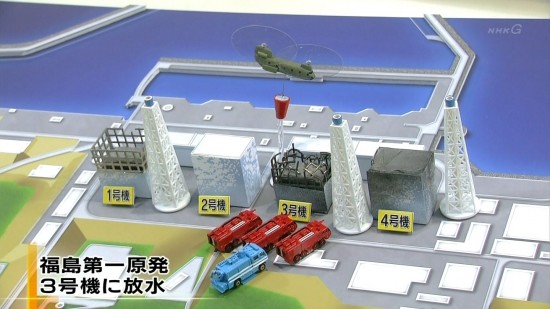
17.51 At 15.55, grey smoke was spotted coming out of unit 3. TEPCO employees have been evacuated as a precaution and the situation is being investigated. The smoke is rising from the south-east side where the spent fuel pool is located. According to NISA there is currently no change in the levels of radiation.
http://www3.nhk.or.jp/news/html/20110321/t10014811101000.html
17.39 A short article addressing the poor coverage of the disaster in Japan by American news sources.
Accurate, unbiased information is crucial in these crises. I was in Chiba when the first explosion at reactor number 1 took place and the lack of information from TEPCO and the government in the first few hours led to speculation that made all of us in Japan fear for our lives. But information was soon forthcoming that allowed me and all Japanese to more rationally evaluate the situation. There were―and are–still problems with getting information in Japan, but even the Prime Minister has publicly criticized TEPCO for keeping information secret and the Japanese media―as one can tell from the sometimes painfully long press conferences at TEPCO and elsewhere―are largely doing their job and asking the right questions. The national network, NHK, has repeatedly urged the continuous release of certain kinds of information. I believe this has led to significant improvements in the information out there. The Japanese networks continue to bring on specialist reporters and university professors with expertise in nuclear reactors to provide rational analysis and expert commentary.
As a result, the Japanese news coverage has been largely calm, rational, informed, and critical. Some of this is naturally to avoid creating panic, but it has been able to do that because as a whole it has answered many of the questions people have and thus gained a certain level of trust. As a media scholar, I can pick this coverage apart for its problems, and of course point to information that is still not getting out there, but on the whole it is functioning as journalism should.It also just looks good because there is something so ugly beside it: the non-Japanese coverage. That, I am afraid, has been full of factual errors and other problems. This has not been just Fox News, but also CNN, MSNBC, ABC, and even the New York Times to differing degrees. They get the reactors mixed up or report information that is simply wrong (e.g., writing that the TEPCO workers had fully abandoned the effort to control the plant because of radiation levels when TEPCO had only withdrawn some non-essential personnel). They are perpetually late, continuing to report things the Japanese media had shown to be wrong or different the day before. They are woefully selective, bringing out just the sensational elements (“toxic clouds” over Tokyo―when in fact radiation in Tokyo now is actually less than that in LA on some days). They are misleading (implying for instance that the dumping of water from the air was some last ditch effort to cool the core, when it was just an effort to replenish the water in the spent rod pools―which are now full in reactor 3 and back to normal temperature).
http://www.talkingpointsmemo.com/archives/2011/03/taking_stock_3.php
**End Live Updates**
02.42 Check out the recent post I wrote for Our Man in Abiko’s QuakeBook – a collection of stories and thoughts from people affected by the earthquake. All proceeds go to the Japan relief effort, so get writing something yourself! Deadline is very soon.
http://gakuran.com/ruminations-on-citizen-journalism-and-media-bias/
02.38 Current figures: 8,277 dead. Combined with the number of missing, the total now reaches over 20,000 people.
http://www3.nhk.or.jp/news/html/20110320/k10014799311000.html
02.27 At a press conference with the Ministry of Defence, it was revealed that continued readings taken by helicopter above units 1-6 showed surface temperatures to be below 100 degrees. This is important data that reinforces the possibility that water is landing in the spent fuel pools and cooling the reactors. Unit 1 = 58C, unit 2= 35C, unit 3 = 62C, unit 4 = 42C, unit 5 = 24C and unit 6 =25C. 100 degrees C is the boiling point of water, so temperatures above this are dangerous because it means the water will evaporate and increase the risk of dry fuel rods – a dire situation that would release a lot of radiation.
そのうえで、北澤大臣は、20日の測定の結果について、それぞれの表面温度は、1号機が58度、2号機が35度、3号機が62度、4号機が42度、5号機が24度、6号機が25度で、いずれも100度未満だったことを明らかにしました。このうち、1号機、3号機、4号機については、使用済み燃料を保管するプールの表面温度とみられるとしています。
As of 21.30 yesterday evening, the Tokyo Fire Department has resumed dousing unit 3 with water. The plan is to continue for 6 hours.
http://www3.nhk.or.jp/news/html/20110321/k10014802761000.html
http://www3.nhk.or.jp/news/html/20110320/t10014801891000.html
March 21st, 2011
16.28 The SDF has been taking temperature measurements from Fukushima Daiichi. Using infra-red rays, they have determined the outer temperature of units 1-4 to be under 100 degrees on the morning of March 19th. Measurements have also been taken today at 13.00 and are under analysis at the government headquarters.
Reactor unit 3 was briefly reported to have pressure rising and a release of steam was being considered in order to lower it, but the situation has stabilised itself and currently no vapour will need to be released. Meanwhile, work continues on connecting the new power lines to the cooling systems.
http://www3.nhk.or.jp/news/html/20110320/k10014795531000.html
http://www3.nhk.or.jp/news/html/20110320/k10014795881000.html
12.11 Focus is now on cooling unit 4. SDF doused it with water for 1 hour this morning and the Fire Department with continue with the cooling in the afternoon.
Both cooling pumps are working on reactors 5 and 6. The temperature of the spent fuel pool at unit 5 has fallen from 68.8 degrees on March 19th, 19.00, to 37.1 (30 degrees is the normal temperature) this morning at 7.00. Unit 6 has fallen form 67.5 degrees to 41 degrees.
http://www3.nhk.or.jp/news/html/20110320/k10014791441000.html
http://www3.nhk.or.jp/news/html/20110320/k10014791481000.html
**End Live Updates** Time for bed. News is slowly getting less and less, which bodes well. But please do not forget that there are still thousands of people living in shelter and many without adequate supplies. The relief efforts are far from over, although I certainly hope the emergency situation at Fukushima nuclear power plant is…
02.04 A bit more to clarify the contamination situation. For spinach, shipments have been stopped and spinach grown in green houses will undergo a further inspection before a final decision is made. For milk, Fukushima prefecture has asked all dairy farmers of Kawamata town to impose a voluntary ban on the shipment of milk with levels of radiation higher than the limit. The substance found was radioactive iodine 131. The prefecture is also checking samples from other towns and cities and has further advised farmers not to consume or sell any produce form within 30km of the Fukushima Daiichi nuclear power plant. (Thanks to Hikosaemon for the links).
http://www3.nhk.or.jp/news/html/20110319/t10014785112000.html
http://www3.nhk.or.jp/news/html/20110319/t10014786361000.html
01.15 Ibaraki prefecture currently holds about 30% of the market share in spinach supply, but due the contamination it is likely not to be sold. In order to avoid disruption, the Ministry of Agriculture, Forestry and Fisheries (MAFF) is looking into alternative supply routes.
(Note: I’m still a little confused as to whether or not it has been decided to stop sale of all spinach from Ibaraki or milk from Fukushima. What is clear is that it is under strict analysis and consideration. I am sure anything over the acceptable level of radiation determined by the Food Hygiene Law will not be sold.)
http://www3.nhk.or.jp/news/html/20110319/t10014788031000.html
http://www3.nhk.or.jp/daily/english/19_21.html
01.10 TEPCO have succeeded in connecting a new external power cable to units 1 and 2. They will undergo inspection today (20th) to check the pump and valves in order to ensure they function. TEPCO is also aiming to restore power to units 3-6 after March 20th. They are calling it their ‘trump card’ in the battle to cool the troubled reactors. However, it is still unknown whether or not the cooling systems can be restored due to the damage they have sustained from the seawater. NISA has said that after restoring power, work will first begin on the meters and gauges, followed by the reactor cooling system and finally the spent fuel pool cooling system.
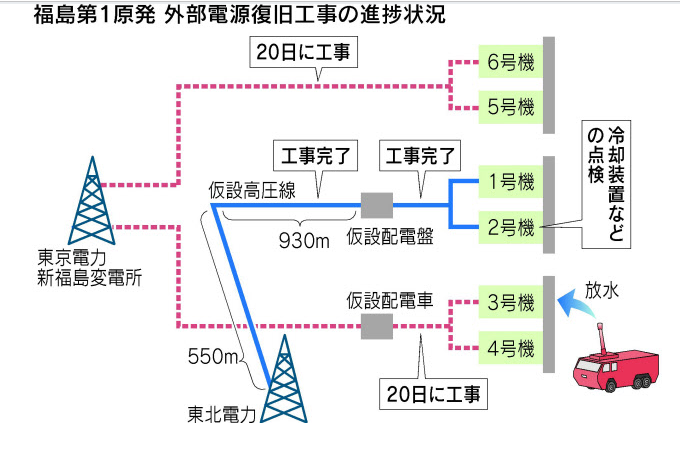
http://www3.nhk.or.jp/news/html/20110319/k10014784751000.html
http://www.nikkei.com/news/headline/article/g=96958A9C93819595E3EBE2E3988DE3EBE2E1E0E2E3E3E2E2E2E2E2E2
00.41 Latest figures. According to the National Police Agency, 7,653 people have been found dead. Combined with the number of missing persons, the total reaches over 19,000.
http://www3.nhk.or.jp/news/html/20110320/k10014789081000.html
March 20th, 2011
23.49 Sir John Beddington, the Chief Scientific Advisor to the UK Government, has revised his ‘Worst Case Scenario’ based on the developments at Fukushima Daiichi nuclear power plant. Essentially, with the addition of the spent fuel pools and potential for drying out, the situation has become a lot worse. This is the reason the U.K and American governments extended their recommended evacuation radius to 80km. If allowed to dry out, spent fuel rods can potentially emit large amounts of radiation into the atmosphere. Although the current situation seems to show units 1-6 under control with plenty of water being pumped on them, it is still important to consider what could happen. This advice from Beddington matches what I posted yesterday from another scientific paper detailing potential plume clouds.
I’m sure it’s very obvious, but this update means that the ‘worst case scenario’ predicted by Beddington a few days ago was not in fact the Worst Case Scenario. The Independent has not missed this fact. To be fair, Beddington was making his assessment based on the current situation with the information he had at the time. Spent fuel pools were not an issue at the time of his first statement. Still, this clearly shows us that there are many factors involved in situations like these and that we cannot always rely on experts to forsee every danger. One more reason to do your own research and remain prudent then.
[Sir John Beddington: JB] Thank you for the opportunity. I wanted to start by clarifying what has changed since I last spoke to everyone at the Embassy and what is happening now.
When we last spoke, concerns were focused around the potential for a meltdown in the reactors. All the analysis we had and nobody is diasagreeing with this, was that the Japanese response to this issue was entirely proportionate. Even with the most unfavourable weather conditions, there were no concerns that radioactivity would reach Tokyo, in any amount to cause a serious health risk.
Since then, the situation has changed. The information we got relatively early on this week was that the ponds, which hold spent fuel rods, had been allowed to dry out, in particular the pond at reactor number four. Now the problem with this is these ponds contain spent fuel rods and those rods are still highly radioactive. The worry that we had is that radiation could start coming out of these ponds, either through fires or minor explosions, generated by hydrogen gas being produced through reactions. And this would mean rather more radiation would be getting into the atmosphere than would have been the case with the reactors alone. So the ponds represent a really big change in the situation. So that was one of the reasons why we thought that it was important to be rather more precautionary, particularly in the area around the plant, and that was the reason for the suggestion and recommendation that has been adopted that we should go out to 80KM. We have discussed this approach with our scientific colleagues in America. We don’t think that there is a massive danger, but we think it is entirely appropriate to be precautionary. You can see from the media reports that there is quite a lot of confusion about what’s going on. So that is the first issue.
In terms of Tokyo, we were asked by the PM to look at what we would do if there was to be a really worst case scenario at the plant, coupled with very unfavourable weather conditions. And even in that worst case scenario, and I would emphasise that this is an extremely unlikely case, even if that happened the level of radiation around Tokyo would be extremely modest. Although there would be radiation increases, even in this extreme case, the effect on human health could be substantially mitigated by just taking very simple precautions. By essentially staying indoors whilst the plume of radiation passed over, not having your ventilation on, and keeping your windows closed. These measures would mitigate any significant risks to human health.
So that’s the current situation and I would emphasise again that this is assuming the most plausible worst case for the nuclear side of it, coupled with the most plausible worst case scenario for weather. Both are unlikely, and in the immediate future the weather forecast still has prevailing winds going out to sea. That is expected to continue until early next week & therefore immediate concerns can be allayed.
We are also working on a plan. If there is some form of release of radioactive material, we would know, and we would be able to monitor approximately how long it would take to reach Tokyo given the current weather conditions, typically 6 or 7 hours. Clearly for other conurbations nearer to the site, the time taken would be slightly less than that. Sendai for example is rather closer. And it will depend entirely then on the direction and speed of the wind.
So to sum up, the additional precautionary zone around the plant is in place as a precautionary measure, but we don’t really think there is a massive problem. In the same way, it is sensible to be precautionary in the context of other conurbations but even in the worst case scenarios we are not particularly worried about the actual human health risks. We think it is important to be precautionary, we have done that. We have looked at worst case scenarios & we’ve tried to analyse them. And can I also say we’ve shared these analyses with both our American and French Colleagues who are getting broadly the same sort of results.
…
[Q] Could we cover the point about contamination of food and water because that is an issue of serious concern for a lot of people here.
[JB] Very happy to. We posed the question to our colleagues in DEFRA and the Food Standards Agency in the UK. The basic message is quite clearly avoid all food from the region of the plant. Clearly given the scale of the devastation in that area, that consideration is very minor. The sort of ways in which the water could be contaminated depends on whether it’s ground water or from reservoirs. But in both cases, the normal sewage filtration processes would take out the enormous majority of any radioactivity so we don’t have any particular concerns. The Japanese authorities would obviously be monitoring the level of radiation in the water. And if this happened in the UK we are pretty certain the sewage system would deal with the problem.
Even after Chernobyl, and please note the risks after Chernobyl were significantly more dramatic and worrying, the risks for water were negligible because of the filtration process that goes into the normal water processing. Bottled water is not a problem at all. The overall risk from drinking tap water is nothing to do with radiation but obviously given the state, particularly in the North East of Japan, there will be real concerns about broken pipes and sewage and the associated microbiology. So it’s not the contamination of the water supplies by radiation but by bacteria which is of more concern and should be thought about. In terms of the food in the shops, anything that is packaged is no problem at all, but I think it would be unwise to eat food produced in gardens and allotments in the vicinity of the region, and anything left out in the open air, which is rare, should not be eaten. These are very much belt and braces recommendations. Anything in cartoon, tin, bottle or a box, is not a problem.[Q] I’d like to clarify something you said the other day. You said you are focused on worst case scenarios and giving advice about those. I am trying to understand exactly what that is. You said the pond reactors dried up and then other reactors suffered problems, but there was no magnification in the radiation that might come to Tokyo. What we have been experiencing is explosions have taken place at the plant, and then they have pulled out their staff, and that in turn has caused many pumps to stop working or water to be stopped pouring. I am assuming that if another one of these reactors goes, they are going to pull everybody out and they won’t put people back in for a longer period. Which might make it more inevitable that all of the reactors will go? So am I correct?
[JB] The problem and why we are so concerned about pond 4 is that if pond 4 is allowed to dry up completely & some form of reaction occurs in pond 4, or even a fire, the radiation dosages that will be coming out would be rather hazardous and would certainly undermine any attempt by the authorities to mitigate that problem. Therefore there is the potential of this meaning that we can’t actually mitigate any problems with the other reactors or ponds. That is in fact how we have actually modelled what we have called the plausible worst case scenario. So your insight is correct.
The point about it is that it would occur over time, it’s not going to happen within hours. And we coupled that with a scenario which assumes the weather stays completely constant in one direction and manifestly that’s not going to be the case. So we think we are making extremely pessimistic assumptions.[Supplementary Question] Just to clarify, you said the other day that even if the reactors were all to go, there would be no cumulative effect and the debris would only go up 500 meters into the air. Is that still your scenario?
[JB ] That’s the case for the reactors but the ponds are a different matter.
[Q ] If ponds are the issue now, which might lead to further radiation, is that because the debris would go up higher? Or what is it that the source of radiation is different?
[JB ] Both really. The point I made in the case of the reactor is that the reactor would melt down, if you failed to keep water in it to keep it cool. There would be a heating up of the core, the core could melt, radioactive material would fall to the bottom of the container vessel, react with concrete causing a build up and then an explosion. But that explosion would be short-lived, in the sense it would send material up to about 500m or so and the height that the radioactive material following such an explosion would be reduced very quickly. For the ponds, they are not going to send up material to that sort of height but will produce a longer and slower emission. It’s not an explosive emission but you could get minor explosions in the pond. It’s why I said the situation has really changed because of the concerns that have been raised about the ponds, particularly pond 4.
[Q]Your advice right now is to consider leaving. It’s not advice to actually leave. Is that unchanged? And secondly at what stage would you change that advice to advice to leave?
[JB] We have indicated what we think our worst case scenario is and we have indicated that you might consider leaving. I think the advice to consider leaving is obviously in part radiation related but there are obviously also other disruptions in the whole of Japan and that would obviously also be a factor in peoples’ consideration. Certainly we are not at this stage advising people to leave because of radiation.
[Q] At what stage would you advise people to leave?
[JB] Obviously if our worst case analysis was wrong and we started to see significant emissions greater than we had actually anticipated in our worst case.
…
[Q] Regarding worst case. Every time you have used the example worst case you have always qualified it with plausible. Is there is implausible worst case and what is that worst case?
[JB] Well of course there is an implausible worst case. So let’s take for example the weather. You could have gale force winds operating for a period of 10 days entirely in the direction of Tokyo & therefore carrying any radiation at lightening speed. That would be an implausible worst case. We’ve certainly assumed in our plausible worst case that all the concerns we have about ponds and reactors have actually occurred. In our plausible worst case we are assuming not all the reactors would blow up at the same time nor would all the ponds go up at the same time. That just seems to us to be implausible and therefore not sensible to model it.
[Q] In your current plausible scenario, do you factor in additional ponds where there are not really serious problems right now.
[JB] Yes
[Q] In the worst case, you are saying that the ponds will cause the problems. Assuming the Japanese are not going to actually tell us when that happens, how will we know that something’s actually happened. Is there going to be a massive explosion? Or is going to be a seepage of radiation that we’re going to hear about?
[JB] I think it would be very clear what has happened as there would be a series of small explosions and fires around the pond.
[Q] In a really worst case scenario, which you’ve said is highly unlikely, what levels of radiation might you expect at ground levels in Tokyo?
[JB] radiation will be at the level where you would be able to mitigate any significant human health risk just by taking simple precautions such as staying indoors when the plume is overhead.
[Q] How long would that plume last?
[JB] That depends on the weather conditions of course, but we’ve been assuming, again utterly worst case scenario, our exposure calculations on the basis of 48 hours continuous exposure out of doors.
…
[Q] Potassium Iodide. Should people living in Tokyo be taking this? And particularly perhaps for children and expectant mothers.
[JB] Obviously the need to take potassium iodide depends on the composition of any plume that is coming. Is there someone on the line from the Health Protection Agency (HPA) who could comment on in what circumstances you might take potassium Iodide?
[HPA] – If we are looking at the worst case scenario then there would be radioactive iodine amongst the radio nuclides in the plume that came to Tokyo. And in that case it would be very sensible for children, pregnant women & nursing mothers to take potassium iodide because children’s thyroids are particularly sensitive to radioactive iodine. You have to take the tablet just before or soon after the plume goes over. If you take the tablet a long time before exposure then it would not do any good. There is no point in taking a tablet unless the worst case scenario happens. But if it does, because of the travel time of the plume to Tokyo there would be time for children to take the tablets, and they would completely block any uptake of radioactive iodine in the thyroid.[JB] Really sorry. I’m going off to another meeting. Hope I’ve been able to answer most of the questions you have been concerned about. The situation has changed in the case of the ponds, we’re hopeful that the Japanese have been able to get water into those ponds, and obviously we’re monitoring this every day. And very shortly we are going to convene another meeting of SAGE (Scientific Advisory Group in Emergencies) whose membership includes nuclear experts, health experts and so on.
http://ukinjapan.fco.gov.uk/en/news/?view=News&id=569052582
17.36 Live press conference with Edano has just finished. Important points to note are as follows. Government notes that the situation is still unpredictable but that they are following the initiative set in place by Prime Minister Kan and showing improvement with each step. Currently the situation at unit 3 is stable and seawater is continuing to be pumped into the reactor.
「菅総理大臣のイニシアティブの下で、官民挙げて事態の悪化を阻止し、事態の収束に向けて全力を挙げている。一歩一歩の改善を見せているが、なお予断を許さない状態だ」
Contamination has been detected in milk from Fukushima prefecture and spinach form Ibaraki prefecture that exceed the allowable amount set under the Food Hygiene Law. Edano has said that the infected products will not be sold and the teams are reviewing necessary regulations in regards to shipping the products. However, even in the event that a person did consume the products, the levels would not be dangerous. For the milk, based on the average milk a person would consume in a year, the amounts of radiation consumed would not exceed the level of a CT scan (6.9mSv based on the chart I uploaded). For a year’s spinach consumption, that amount would be 1/5th the radiation from a CT scan.
http://www3.nhk.or.jp/news/html/20110319/t10014782491000.html
http://www3.nhk.or.jp/news/html/20110319/t10014782131000.html
15.28 The World Health Organisation (WHO) has siad that radiation levels outside of the evacuation zone in Fukushima are not harmful for human health.
WHO spokesperson Gregory Hartl made the remarks at a regular news conference in Geneva on Friday.
The Japanese government issued an advisory on Tuesday to evacuate from a 20-kilometer radius of the Fukushima Daiichi nuclear power plant. It also told people living within a 30-kilometer radius to stay indoors.
He said the amount of radiation being reported outside of the evacuation zone continued to be below the levels considered a public health risk.
He said the WHO finds no public health reason to avoid travel to Japan, except to the affected areas, or to recommend that foreign nationals leave the country.
http://www3.nhk.or.jp/daily/english/19_04.html
15.26 Current figures: 7197 dead. Combined with those missing, the total reaches of 18,000 people.
http://www3.nhk.or.jp/news/html/20110319/k10014777211000.html
15.24 Several TEPCO workers have been exposed to greater than 100mSv of cumulative radiation while working at Fukushima Daiichi nuclear power plant. TEPCO has thus raised the acceptable limit to 150mSv with the provision that any worker leaving the site with more than 100mSv does not go back in. The Ministry of Health, Labour and Welfare raised the limit to 250mSv a few days ago. I presume this is to provide the legal framework for those workers exposed to higher amounts of radiation.
http://www3.nhk.or.jp/news/html/20110319/k10014775591000.html
15.12 Here’s the current situation at Fukushima Daiichi. I’m pleased to report that it’s largely unchanged since yesterday, with more dousing and progress on connecting new power sources to get the cooling systems back online.
Firefighters are soon to resume spraying water on the unit 3 reactor for 7 hours beginning 14.00. The plan is to set up the distance and angle so that the series of connected fire trucks can spray water unmanned. This way, workers are not unnecessarily exposed to radiation. If all goes to plan, 3 tonnes of water will be delivered per minute, filling up the spent fuel pool with 1260 tonnes of water by completion, roughly the same level as normal.
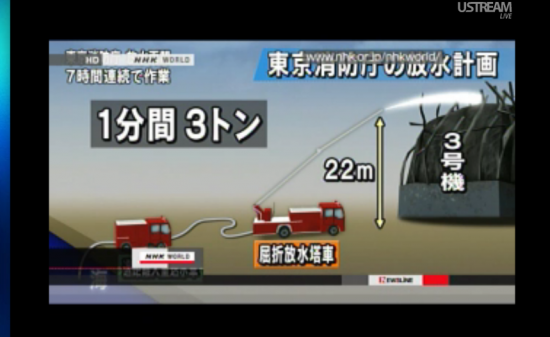
Currently, the power generator at unit 6 has been reactivated and the coolant pump at unit 5 is also operable. Previously both units were being cooled by a single disel generator. Also, work is progressing laying a new 1.5km power line at the site to get the cooling system at unit 2 back online. Unit 2 is being targeted because the structure is largely undamaged, meaning it is difficult to get cooling water inside to the reactor (via NHK World t.v.)
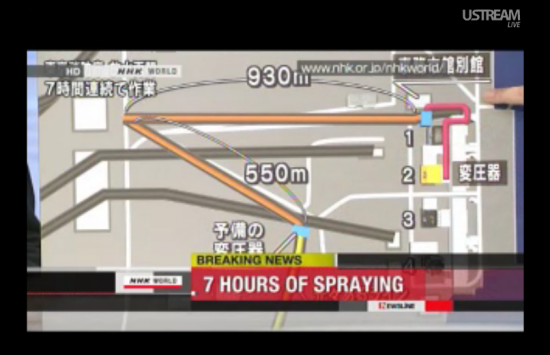
http://www3.nhk.or.jp/news/html/20110319/k10014780481000.html
http://www3.nhk.or.jp/news/html/20110319/k10014778301000.html
http://www3.nhk.or.jp/daily/english/19_15.html
14.31 Another useful picture for reference. This time showing the penetration of various types of radiation.
14.26 A couple of interesting pictures I came across showing the SDF delivering supplies.
Airshot

http://blog-imgs-35-origin.fc2.com/c/h/i/chitekizaisan/20110317-10.jpg
Supplies
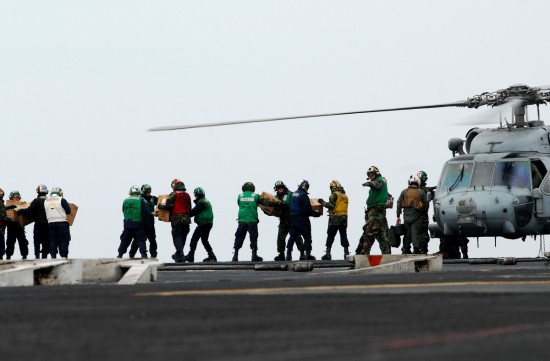
http://blog-imgs-35-origin.fc2.com/c/h/i/chitekizaisan/20110317-8.jpg
13.49 Some more shots of the NHK diorama (模型). The first shot is taken on March 16th, so it’s a little out of date.
Mad props for debuting the helicopter model!
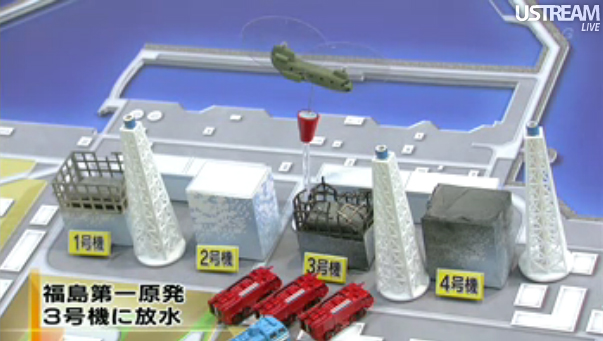
Good view of the entrances and unit numbers (thanks to Daniel Garcia!)
http://blog-imgs-35-origin.fc2.com/c/h/i/chitekizaisan/20110316-7.jpg
http://twitpic.com/4aasqi
http://twitpic.com/4aasqi
**End Live Updates**
01.34 NISA has upgraded the Fukushima Daiichi situation to a level 5 on the IAEA scale of nuclaer incidents. The decision was made to reflect the large amounts of damage done to several of the units and amounts of radiation being exuded into the atmosphere. This puts it on teh same level as the Three Mile Island Accident in the U.S, 1979. Many people have left Fukushima prefecture over the last week due to the situation at the plant (via NHK t.v).
http://www3.nhk.or.jp/news/html/20110318/k10014766251000.html
00.43 Today cooling operations have continued on problem reactors 3 and 4. The SDF used a number of fire engines with extendable arms to blast water down into the damaged roof of both units in an attempt to fill up the spent fuel pool with water. A total of 50 tonnes of water was delivered over a period of 40 minutes. Tonight a task force from the Tokyo Fire and Disaster Management Agency will attempt to keep water pouring on the third reactor. A plan had been devised to link up several fire trucks to shoot water over a long distance, but the damage caused by the earthquake made access difficult. However, the team managed to link up the fire trucks from a great distance to transport water over 300m in order to douse reactor unit 3 from a height of 22m (屈折放水塔車). As of 00.30, the operation started and concluded at 00.50. There are also other teams attempting to install an external power source to return cooling operation to reactor units 1 and 2 (via NHK t.v). Let’s hope that power source is installed quickly and that the cooling operations are successful. The sooner the better, to stop these brave people from being exposed to too much radiation.
http://www3.nhk.or.jp/news/html/20110318/k10014761891000.html
http://www3.nhk.or.jp/news/html/20110318/t10014773791000.html
http://www3.nhk.or.jp/news/html/20110319/k10014774641000.html
00.40 NHK has been using a diorama to illustrate the situation at Fukushima Daiichi. It’s rather cute and made a few headlines itself on the internet, impressing various bloggers and twitterers.
More shots here: http://izreloaded.blogspot.com/2011/03/diorama-of-damaged-japanese-nuclear.html
00.23 Daniel Garcia put together this satellite image showing the various locations of the units and the gates. The west gate and main entrance are important because it shows where TEPCO is taking their readings.
The latest TEPCO readings are also out. Constant decreases in radiation in both plants 1 and 2.
http://www.tepco.co.jp/cc/press/betu11_j/images/110318d.pdf
http://www.tepco.co.jp/cc/press/betu11_j/images/110318e.pdf
March 19th, 2011
23.13 The nuclear situation from a child’s perspective: ‘Genpatsu-kun’.
http://www.youtube.com/watch?v=O1aH2-MhEko
21.13 Latest figures released by the National Police Agency. 6,911 dead, 10,316 persons missing. Also, 29 people have died while being evacuated, thought to be from shock or the stress of living as a refugee.
http://www.npa.go.jp/archive/keibi/biki/higaijokyo.pdf
http://www3.nhk.or.jp/news/html/20110318/k10014764851000.html
20.45 Radiation levels around Fukushima for March 16th have been put into handy graph format. They are the official figures by MEXT, measure in MICRO sieverts. The highest value at the edge of the 30km zone is 150uSv/h. So, in the millisievert units I’ve been using most often on this website, that’s 0.15mSv/h. That’s a high amount for people living on the 30km border (remember it accumulates every hour). There are also some 0.04 and 0.05mSv.h values around the 30km border (about the value of a chest x-ray), but the rest are much lower. Still, considering these values were taken at the 30km border, I wouldn’t want to be someone living just outside the evacuation radius. It’s been several days now that the plant has been spewing out radiation and it all gradually builds up.
Here’s the Fukushima area map above.
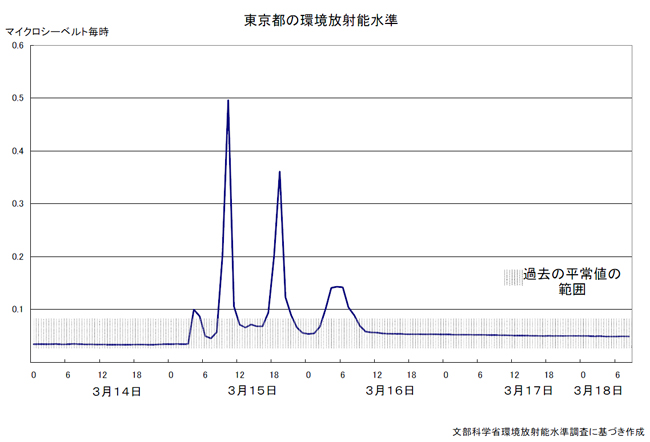
And here’s the levels of radiation in Tokyo. Levels are very low and not a cause for concern.
http://www.mext.go.jp/a_menu/saigaijohou/syousai/1303732.htm
http://www.mext.go.jp/a_menu/saigaijohou/syousai/1303726.htm
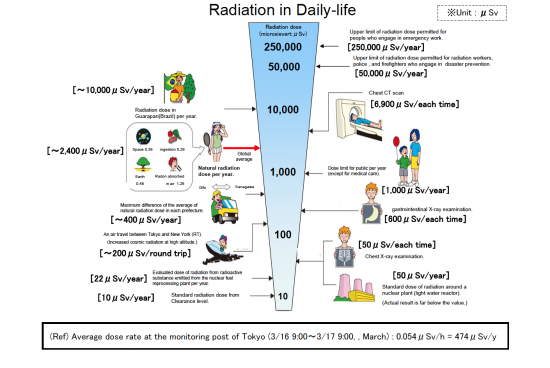
Above: English safety readings from MEXT (in MICRO uSv). Same as I posted days ago.
PDF for Posterity.
PDF for Posterity.
19.29 Here’s a nice chart of what you might find in a standard survival bag in Japan.

http://www.bbc.co.uk/news/world-asia-pacific-12759840
18.26 Here’s more necessary reading for those of you still not convinced by current explanations that the levels of harmful radiation being given off are localised. In other words, outside the 30km zone, there’s very little effect. From Ben Monreal, UCSB Physics Dept.





http://online.itp.ucsb.edu/online/plecture/bmonreal11/pdf/BMonreal11_PublicLecture_KITP.pdf
PDF for Posterity.
Confused? The whole lecture is here in video form. It’s completely engrossing and expertly presented. If you’ve been at all interested in the events of late, I advise you put aside 80 minutes and enjoy this introduction to radioactivity. He makes an excellent point partway through saying that we have all the information. We can measure the radiation levels, we know what a Sievert is and we can decide our own what our risk tolerance is. The people at Chernobyl had none of this. http://online.itp.ucsb.edu/online/plecture/bmonreal11/
Here’s an animated gif (I know, so 90’s!) from a difference source showing the radioactive plume from Fukushima Daiichi. Not many observations I can make except the fact that it’s good most of the radiation went out to sea. All radiation that has reached Tokyo and other parts of Japan so far has been tiny and insignificant.

http://www.zamg.ac.at/pict/aktuell/20110317_fuku_I-131.gif
11.58 Our man in Abiko has thought up a brilliant way to help the Japan effort. He’s looking to collect articles written by people involved and put them together in book form. All proceeds go towards the disaster stricken areas.
Here’s the deal:
I’m looking for contributions from anyone who has something to say about the earthquake. (eg where were you when it happened, what did you feel? How have you helped? Did it change anything in the way you live your life? Are you coping with grief? Or just bewildered behind a barrage of media images?)
I’m not looking for windy poetic stuff, just honest stuff.
Aim to write 250-300 words or so – equivalent to a short blog post (or one page of a book)
If you can contribute original (ie you have the copyright) artwork, a sketch drawing or cartoon that would be awesome too)
If you have any great tweets to submit – that would be great too.
Photos (that you took) would be really awesome.
http://ourmaninabiko.blogspot.com/2011/03/japan-earthquake-get-writing-now.html
09.55 Worst Case Scenario 2. I posted yesterday an excellent analysis from the UK Government’s Chief Scientific Officer Professor John Beddington of what the worst case scenario might be at Fukushima. I think it’s important to consider the worst in view of the seriousness of the situation – it is not my aim to unitentionally worry you. I noted that the report did not include analysis of the spent nuclear fuel rods currently exposed in unit 4. If the water cooling these rods falls and they heat up to melting point, large amounts of radiation will be given off. Below is another scientific report of what could happen. (Credit to Gregory Flynn and his friend who found the article!)
Essentially, the article says that potential zirconium alloy cladding fires could result in radioactive contamination of thousands of square kilometres, much larger than the areas contaminated in the Chernobyl accident. We also saw recently that high levels of radiation were recorded above units 1-4 at Fukushima (250mSv/h). I do not know if these levels of radiation suggest that the spent fuel rods are melting.
Now I’m really pushing the limits of what I can accurately analyse here as I am both out of my field and depth, but it seems to me that in the article the contaminated area at Chernobyl is given at 700km2, whereas in other sources I have noted that the only radiation that was shown to have health effects in the Chernobyl incident was limited to a 30km radius. So what does this mean? Should we be concerned about radiation travelling hundreds or thousands of kilometres in the event of a zirconium fire? What would be the effects on the health of people within those distances? I would welcome any help clarifying this matter – please contact me on Twitter.
**Update** Once again I’m indebted to friends Chris and Fukumimi on Twitter pointing out the obvious.
The Chernobyl 30km radius would be approximately 2800km2 (pi x radius squared = area) – entirely consistent with the 700km2 mentioned above. Incidentally, 700km2 is a 15km radius (square root of area/pi).
In the worst case scenario Wedge model then, 50,000km2, the radius of contamination would be about 125km. Huge, but still not as far as Tokyo. Do not forget however, that this is only a model that is divorced from the current situation at Fukushima. It also does not account for environmental factors like strong winds.
I think I need to go back to school. That was embarrassing.
Abstract: Nuclear power reactors have created a significant quantity of used or spent nuclear fuel elements that contain some remaining nuclear fuel and by products of the fission process that are highly radioactive. Lack of a secure central repository or other permanent disposal process for spent nuclear fuel elements has resulted in long term storage of these elements in spent fuel pools at operating nuclear power plants. A recent review of the safety and security of commercial spent nuclear fuel expressed concern that terrorist activity at a spent nuclear fuel storage pool could result in a zirconium cladding fire that could create widespread radioactive contamination with dramatic impact on both the public and the environment. A scenario based on such an event is presented to demonstrate the potential impact resulting from the release and dispersion of spent fuel products.
…
Nuclear power reactors have been producing electrical power for almost five decades (Radiochemistry Society). The nuclear energy in this process comes from nuclear fission of enriched uranium fuel elements. A typical nuclear power reactor core contains approximately 75 metric tons of uranium (MTU) fuel that is in the form of ceramic pellets enclosed in a metal tube called a fuel rod. The metal tube or cladding for power reactors is usually an alloy made of zirconium or zircaloy. Several fuel rods are combined into an assembly that is placed into the reactor core. Over time the efficiency of the fission process in a fuel assembly is decreased, due to loss of fissionable atoms and build-up of other materials, so the fuel assembly is replaced. Typically about one-third of a reactor core, about 25 MTU, is replaced each year so a portion of the core that was installed at a given time, will be in the core for approximately three years (World Nuclear Association). The fuel element assemblies that are removed are called spent fuel and contain some remaining uranium fuel, some radioactive elements that were producedby activation or activation products, and a variety of highly radioactive isotopes referred to as fission products.
…
The fission products in the spent fuel create very high radiation levels in the area surrounding the fuel. This is particularly true during the first year after the fuel is removed from a reactor, but even ten years after removal of spent fuel from a reactor, the radiation dose 1 metre away from a typical spent fuel assembly exceeds 200 Sv per hour (US Nuclear Regulatory Commission, 2002). Energy produced by the radioactive decay within the fuel elements results in heat. If heat is not removed, the assemblies can reach temperatures that can result in the rupture of the zirconium alloy cladding or even a zirconium cladding fire that can release very high concentrations of the radioactive contents. For this reason, spent fuel elements are typically stored under water in spent fuel pools. Water in the pools serves as a shield to reduce radiation to acceptable levels and as a heat transfer medium to cool the fuel (World Nuclear Association).
…
If an attack on a spent fuel storage facility occurs that either causes the water in the pool to be released or prevents any cooling of the existing water allowing the water to evaporate, the fuel assemblies in the pool could begin to overheat. The fuel assemblies that were most recently removed from the reactor would be in danger of melting of the cladding due to their high fission product inventories and the resulting high heat of decay production. In some cases, particularly at PWRs, the whole reactor core is placed in the fuel storage pool during refuelling and maintenance operations. If this were the case,the core would greatly add to the heat load in the pool. If the water level in the pool is reduced to expose some of the fuel assemblies, the radiation levels in the building will become very high. This would limit the ability of plant personnel to enter the area to mitigate the problem. Automatic water spray systems might reduce the heating if they are available and operational. However, assuming that the fuel continues to get hotter, then it will eventually stress the cladding material sufficiently to rupture, and release of the radioactive contents would be expected. Approximately 5% of the volatile fission products could be released due to fuel element gaps (McKenna al., 1996, Section D). As the fuel assemblies continue to heat, oxidation of the zircaloy-cladding material will occur and if sufficiently high temperatures occur, the oxidation reaction can become self-sustaining and highly exothermic. This is referred to as a zirconium cladding fire. The oxidation process is enhanced by the presence of steam. The heat resulting from the cladding fire can add to the existing heat in the assemblies and cause the cladding fire to spread to nearby fuel assemblies. Cladding fires can lead to releases of between 10 and 100% of the volatile fission products in the fuel assemblies that are involved. The heat from the cladding fire can create convective currents that carry the volatile contaminants away from the facility where the public and the environment would be impacted.
…
The degree that contamination from a spent fuel fire could be spread to the surrounding environments and its impact on the public are subject to a large number of variables such as height of the release, temperature of the exhausted gases, wind direction and speed and many others. There are several dispersion models that are designed to estimate the spread of a release such as a spent fuel cladding fire. The authors tested three different computer based models to determine if any were appropriate for a spent fuel fire scenario. A review of recent literature also revealed several reports/papers that used such models to predict the impact of a major release of radioactive contaminants such as from a spent fuel fire.
…
The US Nuclear Regulatory Agency in the report ‘Technical Study of Spent Fuel Pool Accident Risk at Decommissioning Nuclear Power Plants’ NUREG-1738 (US Nuclear Regulatory Commission, 2001) did extensive testing of the risk of a significant accident at a spent fuel pool. The results indicated a very low risk of occurrence; however, the report was written in January 1991, prior to the 9/11 event and did not deal with the potential of a well planned terrorist attack. The analysis showed that the consequences of a spent fuel pool accident could be comparable to those for a severe reactor accident. The consequences would vary based on the population density around the plant and weather conditions; however, potential consequences could include nearly 200 early fatalities and thousands of latent cancer fatalities. Two recent articles in Science and Global Security dealt specifically with the spent fuel issue (Alvarez et al., 2003; Beyea et al., 2003). The authors of these papers useda Wedge Model and the MELCOR Accident Consequence Code System (MACCS2), a Gaussian plume dispersion code, to estimate the impact on the surrounding environment and public from a spent fuel fire. Source terms of 0.13 EBq (3.5 MCi) and 1.3 EBq (35 MCi) of Cs-137 were used to calculate the potential impact on the surrounding environment and public. The projected plume areas that were calculated by each of these modelling systems are shown in Table 2 and compared with the estimated areas contaminated during the 1986 Chernobyl reactor accident. The predicted plume areas for both source terms and models were much greater than for the Chernobyl incident. (emphasis added) Projected plumes were compared to population densities for five different commercial power reactors in the United States to estimate the impact on the public and the cost to purchase or decontaminate the areas back to habitable levels. The estimated cost of decontamination ranged from $5 billion to $199 billion US$. Approximately 1900 cancer deaths were predicted for the 0.13 EBq release and 5700 cancer deaths for a 1.3 EBq release.
…
However, if an attack were to occur and result in loss of water in the pool, allowing the spent fuel to overheat, rupture of the fuel elements or zirconium alloy cladding fires could result. The radioactive contamination that could be released into the environment from such an event could contaminate thousands of square kilometres, result in billions of dollars in economic impact and large numbers of both early and latent cancer deaths. The use of other means including dry storage casks, direct disposal and reprocessing for reducing the number of fuel assemblies stored in spent fuel pools could reduce the potential for such an incident.
From the NY Times article:
Richard T. Lahey Jr., a retired nuclear engineer who oversaw General Electric’s safety research in the early 1970s for the kind of nuclear reactors used in Fukushima, said that the zirconium cladding on the fuel rods could burst into flames if exposed to air for hours when a storage pool lost its water.
Zirconium, once ignited, burns extremely hot and is difficult to extinguish, added Mr. Lahey, who helped write a classified report for the United States government several years ago on the vulnerabilities of storage pools at American nuclear reactors.
Very high levels of radiation above the storage pools suggest that the water has drained in the 39-foot-deep pools to the point that the 13-foot-high fuel rod assemblies have been exposed to air for hours and are starting to melt, said Robert Albrecht, a longtime nuclear engineer who worked as a consultant to the Japanese nuclear reactor manufacturing industry in the 1980s. Under normal conditions, the rods are kept covered with 26 feet of water that is circulated to prevent it from growing too warm
http://www.nytimes.com/2011/03/18/world/asia/18spent.html
http://inderscience.metapress.com/link.asp?id=r708m13065725707
March 18th, 2011









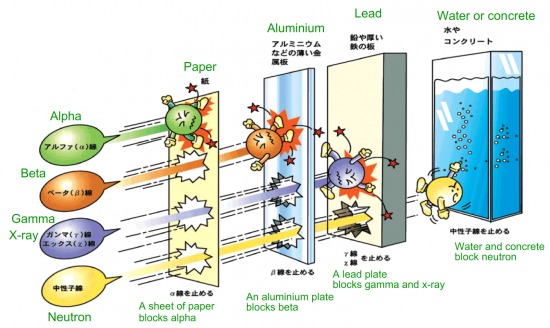
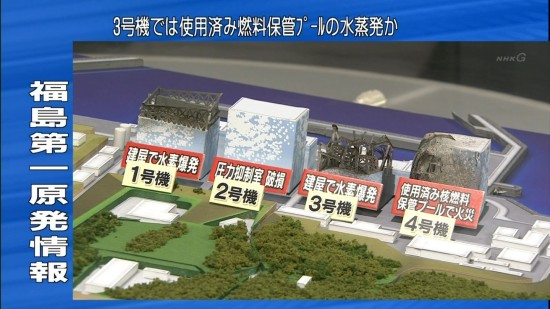


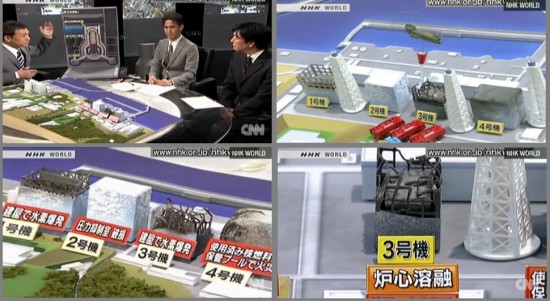

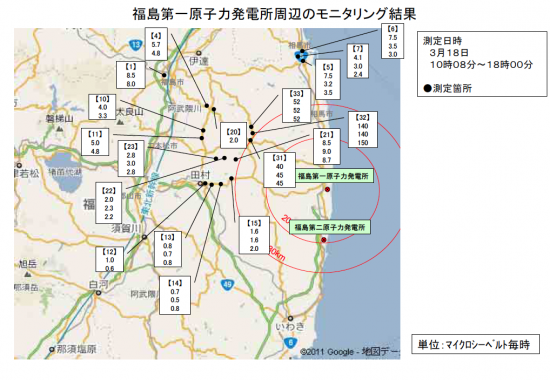

Incredible amounts of detailed earthquake information here. Thank you.